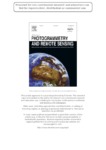Por favor, use este identificador para citar o enlazar este ítem:
http://www.alice.cnptia.embrapa.br/alice/handle/doc/924819Registro completo de metadatos
| Campo DC | Valor | Lengua/Idioma |
|---|---|---|
| dc.contributor.author | LI, G. | pt_BR |
| dc.contributor.author | LU, D. | pt_BR |
| dc.contributor.author | DUTRA, L. | pt_BR |
| dc.contributor.author | BATISTELLA, M. | pt_BR |
| dc.date.accessioned | 2014-09-17T07:35:35Z | - |
| dc.date.available | 2014-09-17T07:35:35Z | - |
| dc.date.created | 2012-05-17 | pt_BR |
| dc.date.issued | 2012 | pt_BR |
| dc.identifier.citation | ISPRS Journal of Photogrammetry and Remote Sensing, v. 70, p. 26-38, 2012. | pt_BR |
| dc.identifier.uri | http://www.alice.cnptia.embrapa.br/alice/handle/doc/924819 | pt_BR |
| dc.description | This paper explores the use of ALOS (Advanced Land Observing Satellite) PALSARL-band (Phased Array type L-band Synthetic Aperture Radar) and RADARSAT-2 C-band data for land-cover classification in a tropical moist region. Transformed divergence was used to identify potential textural images which were calculated with the gray-level co-occurrence matrix method. The standard deviation of selected textural images and correlation coefficients between them were then used to determine the best combination of texture images for land-cover classification. Classification results based on different scenarios with maximum likelihood classifier were compared. Based on the identified best scenarios, different classification algorithms ? maximum likelihood classifier, classification tree analysis, Fuzzy ARTMAP (a neural-network method), k-nearest neighbor, object-based classification, and support vector machine were compared for examining which algorithm was suitable for land-cover classification in the tropical moist region. This research indicates that the combination of radiometric images and their textures provided considerably better classification accuracies than individual datasets. The L-band data provided much better landcover classification than C-band data but neither L-band nor C-band was suitable for fine land-cover classification system, no matter which classification algorithm was used. L-band data provided reasonably good classification accuracies for coarse land-cover classification system such as forest, succession, agropasture, water, wetland, and urban with an overall classification accuracy of 72.2%, but C-band data provided only 54.7%. Compared to the maximum likelihood classifier, both classification tree analysis and Fuzzy ARTMAP provided better performances, object-based classification and support vector machine had similar performances, and k-nearest neighbor performed poorly. More research should address the use of multitemporal radar data and the integration of radar and optical sensor data for improving land-cover classification. | pt_BR |
| dc.language.iso | eng | eng |
| dc.rights | openAccess | eng |
| dc.subject | ALOS PALSAR | pt_BR |
| dc.subject | RADARSAT | pt_BR |
| dc.subject | Land-cover classification | pt_BR |
| dc.subject | Amazon | pt_BR |
| dc.title | A comparative analysis of ALOS PALSAR L-band and RADARSAT-2 C-band data for land-cover classification in a tropical moist region. | pt_BR |
| dc.type | Artigo de periódico | pt_BR |
| dc.date.updated | 2014-09-17T07:35:35Z | pt_BR |
| dc.subject.nalthesaurus | texture | pt_BR |
| dc.format.extent2 | p. 26-38. | pt_BR |
| riaa.ainfo.id | 924819 | pt_BR |
| riaa.ainfo.lastupdate | 2014-09-16 | pt_BR |
| dc.contributor.institution | GUIYING LI, INDIANA UNIVERSITY; DENGSHENG LU, INDIANA UNIVERSITY; LUCIANO DUTRA, INPE; MATEUS BATISTELLA, CNPM. | pt_BR |
| Aparece en las colecciones: | Artigo em periódico indexado (CNPM)  | |
Ficheros en este ítem:
| Fichero | Descripción | Tamaño | Formato | |
|---|---|---|---|---|
| MateusISPRS.pdf | 2.25 MB | Adobe PDF |  Visualizar/Abrir |









